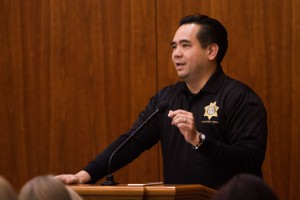
Fifteen to 40 million victims suffer from human trafficking worldwide today, according to Utah Attorney General Sean Reyes. But the issue isn’t only a problem for developing nations; human trafficking is a real problem in Utah too.
In the coming Utah legislative session, which starts on Jan. 25, legislators will discuss H.B. 105, a bill sponsored by Rep. Angela Romero, which adds a technical provision left out in last year’s legislation. H.B. 105 provides that a human trafficking defendant cannot use his or her mistaken belief that a victim was 18 or older as a defense against the crime of human trafficking a child. Romero, along with other legislators, is currently drafting other anti-human trafficking bills.
“There are so many vulnerable young people out there who fall victim to human trafficking,” Romero said. “It is our duty to protect them and make sure we have the resources to protect them. Until we really capital (the human trafficking problem), it will kind of be in the shadows.”
Reyes told a group of BYU students earlier in the month that human trafficking happens everywhere, although some may not perceive it as a Utah problem. He spoke about local cases to illustrate his point. One of the biggest cases in the Mountain West was that of Victor Rax.
In 2014, a friend told Reyes one of his friends was worried his son was being trafficked. Reyes quickly dispatched an investigation team that confirmed the human trafficking was occurring, which led Utah’s SECURE Strike Force to arrest Rax on Feb. 12, 2014. Rax was an M13 gang member who had been deported seven times, but he kept returning to run human trafficking organizations before finally being apprehended in West Valley City.
This time they successfully delayed deportation in order to prosecute Rax in the United States. Ultimately, 60 victims came forward to testify against Rax, who was later found dead in his jail cell. The court continued with the case to give victims closure and healing.
The Rax case outsized other human trafficking cases in Utah, but Reyes emphasized trafficking does occur and not just in rare instances.
“It’s prevalent, much more than people realize,” Reyes said.
Recent efforts to combat human trafficking has made Utah an example for other states, according to Reyes. Other states’ officials look to Utah for training. The Utah Attorney General’s Human Trafficking Task Force will host two focus groups for victims and healthcare providers on Jan. 27, 2016.
One of the focus group leaders, Laura Lederer, recently conducted a study which found that 99.1 percent of human trafficking victims had physical health problems and 87.8 percent had seen a healthcare provider during the time they were trafficked. The focus groups hope to better prepare healthcare providers to identify victims of human trafficking.
“The hope is that this national study and the training that will come from it will enable prevention and improve interaction between healthcare providers and law enforcement to bring more perpetrators of this heinous crime to justice,” Lederer said in a press release.
The Utah Attorney General’s Human Trafficking Task Force, in partnership with the National Association of Attorneys General, will also host training for prosecutors and investigators on Jan. 28 and Jan. 29 in Salt Lake. The training will include discussions about the overall issue and the legal frameworks and strategies available for investigation and prosecution.




